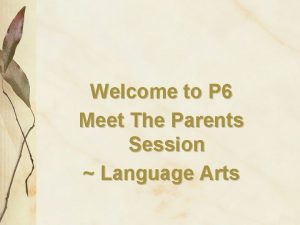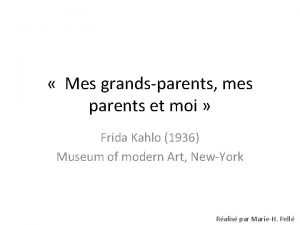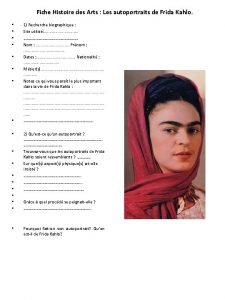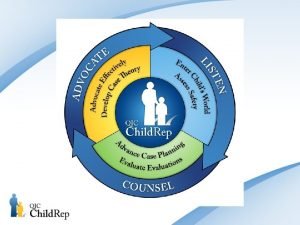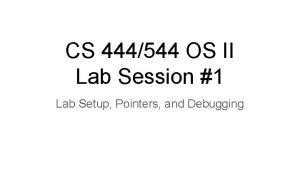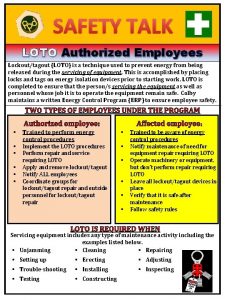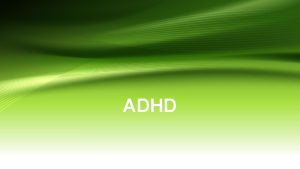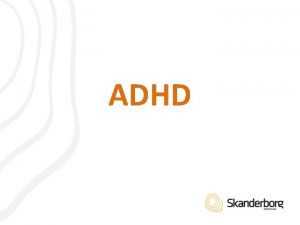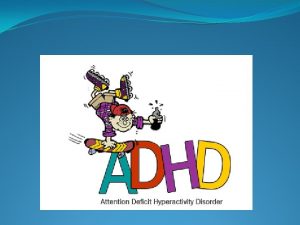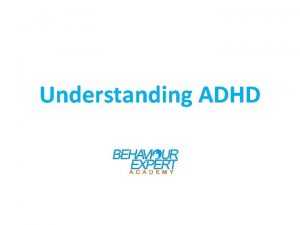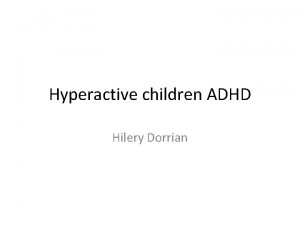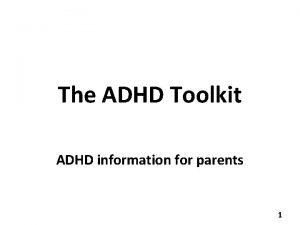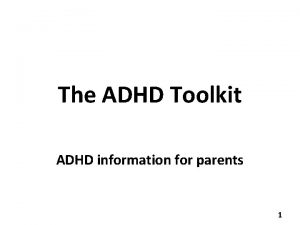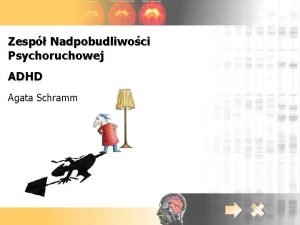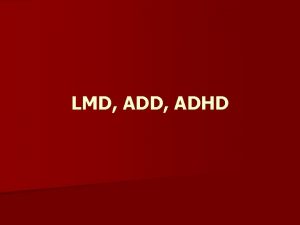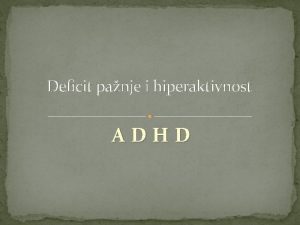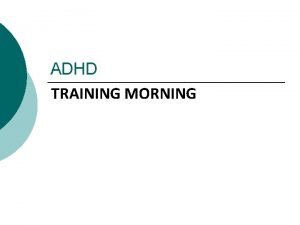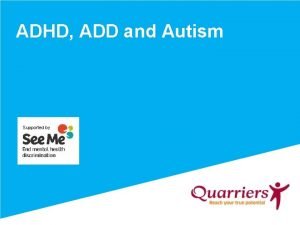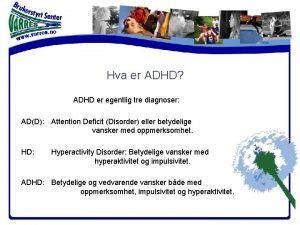SESSION 1 Understanding ADHD TIME OUT FOR PARENTS





















































































- Slides: 85


SESSION 1 Understanding ADHD

TIME OUT FOR PARENTS AIMS TO: • Help you better understand ADHD and its effects on a child • Enable you to better manage your child's behaviour • Increase your confidence in your skills and abilities as a parent • Help the relationship between you and your child be better, or even better, than it is now

TIME OUT FOR PARENTS AIMS TO: • Teach you skills to help raise your children’s self-esteem • Identify the best way to effectively discipline your child • Encourage everyone on the course to give each other mutual support • Give you the tools to help you in your relationship with your child’s other parent or carer • Provide you with greater support where you would like it

SESSION PLAN • What is ADHD? • How ADHD is diagnosed today • Sensory processing difficulties • Social, emotional, physical and academic difficulties • How the ADHD brain works • Building self-esteem

ATTENTION DEFICIT HYPERACTIVITY DISORDER Three presentations: 1. Predominantly inattentive presentation – mainly symptoms of inattention 2. Predominantly hyperactive/impulsive – presentation – mainly symptoms of hyperactivity/impulsivity 3. Combined – when symptoms of inattention, hyperactivity/impulsivity are present

THE HISTORY OF ADHD • 1845: Heinrich Hoffman first described ADHD behaviours. • 1987: the American Psychiatric Association used the term attention hyperactive disorder. • 1990: Jean Ayers described difficulties in sensory and motor planning. • 1990: PET scan evidence presented.

THE HISTORY OF ADHD • 1994: DSM IV puts ADHD and ODD under one heading, attention-deficit and disruptive behaviour disorder. • 2009: diagnoses and treatment guidelines released. • 2013: American Psychiatric Association classification – ADHD. • 2017: World Health Organisation classification – ADHD.

WHAT WE KNOW ABOUT ADHD • Tends to run in families • Exact cause unknown • Affects 2– 5% of children in the UK • More boys diagnosed • Not because of ‘bad parenting’

ADHD BEHAVIOURS • Inattentive • Hyperactive • Impulsive

HOW ADHD IS DIAGNOSED TODAY • Referral is made by the school SENCO or GP • Diagnosis is made by a child psychiatrist or paediatrician

HOW ADHD IS DIAGNOSED TODAY 1. Predominantly inattentive – child has six or more symptoms of inattentiveness 2. Predominantly hyperactive/impulsive – child has six or more symptoms of hyperactivity and impulsiveness 3. Combined – child has six or more of inattentiveness and six or more of hyperactivity/impulsiveness

HOW ADHD IS DIAGNOSED TODAY Getting an assessment for a child with ADHD in the UK is not easy so it is important that you: • gather as much information and evidence as you can • keep a diary of the difficulties you observe at home • ask the school for written reports on behaviours observed at school • make a list of particular incidents – what happened and where

SENSORY PROCESSING DIFFICULTIES

SENSORY PROCESSING DIFFICULTIES • Extra-sensitive – will find sensations uncomfortable or painful and avoid them. • Under-sensitive – may not register a sensation and may crave input into those senses.

BREAK

SOCIAL, EMOTIONAL, PHYSICAL AND ACADEMIC DIFFICULTIES

HOW THE ADHD BRAIN WORKS

THE PRINCIPLE CHOICE FOR PARENTS OF ADHD CHILDREN EITHER • Accept the condition • Come to terms with specific difficulties that won’t change and work round them • Help the child feel they are a valued member of the family OR • Make no allowances • Be critical and hostile • Deal with the child more and more forcefully

“God grant me the serenity to accept the things I cannot change, courage to change things I can, and wisdom to know the difference. ” Reinhold Niebuhr

HOW THE ADHD BRAIN WORKS Children with ADHD often have very low self-esteem and they need us to be ‘on their side’.

BUIDLING SELF-ESTEEM

BUIDLING SELF-ESTEEM Create an emotional climate of warmth, unconditional love, support, tolerance, forgiveness and kindness.

REFLECTION • We have started to understand what ADHD is and how the ADHD brain works. • We have thought about what it is like to have a child with ADHD and the behaviours that are associated with the condition. • We have looked at how ADHD is diagnosed. • We have considered sensory processing difficulties in a child with ADHD.

REFLECTION • We have considered some of the social, emotional, physical and academic difficulties that a child with ADHD will have and thought about some ways we can help. • We thought about the choice we have as parents either to accept or reject our child’s condition and how this will affect the way we deal with their behaviour. • We thought about the importance of building up our child’s self-esteem.

FOCUS FOR THE WEEK • Make a list of 10 things you love about your child and share it with them. • Keep a record of every negative thing you say to your child and make sure you say at least as many positive things.

NEXT WEEK We will look at attention deficit behaviour and strategies to help manage this.

SESSION 2 Attention deficit

SESSION PLAN • • • What is attention? Attention deficit behaviours Managing attention deficit Behaviour management School strategies Sleep

WHAT IS ATTENTION? The attention process has three parts: • Being alert • Selecting and sustaining • Shifting focus

ATTENTION DEFICIT BEHAVIOURS

ATTENTION DEFICIT BEHAVIOURS For a diagnosis of ADHD predominantly inattentive presentation: If six or more symptoms of inattention (but less that six symptoms of hyperactivity/impulsivity) have persisted for six months.

MANAGING ATTENTION DEFICIT

BREAK

BEHAVIOUR MANAGEMENT

BEHAVIOUR MANAGEMENT • Routines • Consistent rules • Give clear commands • Physical exercise • Be super organised!

SCHOOL STRATEGIES

SCHOOL STRATEGIES It is easy for the relationship with the school to become confrontational but it will be best for your child if you can work together and share insights and ways of dealing with your child’s behaviour.

SLEEP Sleep difficulties are very common in children with ADHD, sleep disorders include: • Insomnia • Nightmares or night terrors • Snoring or breathing problems

TOP TIPS FOR A BETTER NIGHT’S SLEEP

REFLECTION • We have learnt that people with attention deficit have difficulty being alert, selecting and sustaining attention and coping with distractions. • We have learnt the importance of routines, consistent rules, clear commands, physical exercise and of being super organised ourselves. • We have also thought about how we can work with our child's school. • We have considered ways to help our child get a better quality night's sleep.

FOCUS FOR THE WEEK • Try to identify at least two strategies you might be able to use this week to manage attention deficit behaviours that may worry you. • Make a note of what you tried.

NEXT WEEK We will be looking at hyperactivity and strategies to help manage this.

SESSION 3 Hyperactivity

SESSION PLAN • • • What is hyperactivity? Hyperactive behaviours Managing hyperactivity Behaviour management Oppositional behaviour

WHAT IS HYPERACTIVITY? • Hyperactivity is a high level of movement, restlessness, or fidgeting. • Overactive (or hyperactive) children tend to be continually ‘on the go’. They may seem loud and noisy with continuous chatter.

HYPERACTIVE BEHAVIOURS

MANAGING HYPERACTIVITY

BREAK

BEHAVIOUR MANAGEMENT • • Routines Consistent rules Clear commands Physical exercise Be super organised Daily activities to increase alertness and to calm Rewarding good behaviour Not rewarding undesirable behaviour

‘DRIVEN BY A MOTOR’

YOUR CHILD’S ‘ENGINE SPEED’ Daily activities to increase alertness and to calm

REWARDING BEHAVIOUR

REWARD GOOD BEHAVIOUR Children with ADHD need lots of praise!

DON’T REWARD UNDESIRABLE BEHAVIOUR

OPPOSITIONAL BEHAVIOUR Around half of the children with ADHD also have oppositional behaviour and a small percentage of these will also be diagnosed with oppositional defiant disorder.

REFLECTION • We have learnt that people with ADHD have difficulty filtering out irrelevant information. • We have considered the importance of routines, consistent rules, clear commands, rewarding good behaviour and not rewarding undesirable behaviour. • We have tried one method of helping our child, and ourselves, to relax.

FOCUS FOR THE WEEK • Note which of your child’s hyperactive behaviours are of particular concern to you. • Identify at least two strategies you might be able to use this week to manage them.

NEXT WEEK We will look at impulsive behaviours and strategies to help manage this.

SESSION 4 Impulsivity

SESSION PLAN • • • What is Impulsivity? Impulsive behaviours Behaviour management Managing constant demands and anger Treatment options for ADHD Coping strategies for parents

IMPULSIVE BEHAVIOURS Someone who has ADHD often says or does the first thing which comes into their head.

THE ADHD BRAIN Cerebral cortex Thinking Limbic system (thalamus and amygdala) Emotions Emotional – Thinking Link

IMPULSIVE BEHAVIOURS

UNIQUE AND DIFFERENT

UNIQUE AND DIFFERENT • Teach them to say sorry • Forgive them quickly

BEHAVOUR MANAGEMENT

BEHAVOUR MANAGEMENT • • Routines Consistent rules Clear commands Physical exercise Be super organised Daily activities to increase alertness and to calm Rewarding good behaviour Not rewarding undesirable behaviour

PLANNING AHEAD

STOP, THINK AND PROCEED

CONSEQUENSCES AND SANCTIONS Children with ADHD don’t learn easily from consequences

I-MESSAGES

BREAK

MANAGING CONSTANT DEMANDS AND ANGER “No!” “Stop!” “Don’t touch!”

THE ANGER CYCLE

BOTTLED UP

FIREWORKS

TREATMENT OPTIONS Psychological interventions should always be the first line of treatment, then pharmacological treatment is considered.

ADHD AND MEDICATION

ADHD AND DIET

COPING STRATEGIES FOR PARENTS • • • Anger management ‘Me time’ Sleep Support groups Choose your battles

THINK POSITIVELY Many negative characteristics of ADHD can have a positive side.

REFLECTION • We have thought about behaviour management at school and looked at examples of good practice both at school and home. • We have looked at impulsive behaviour in children with ADHD and recognised that they don’t mean to get into trouble; they just act with no thought of the consequences. • We have considered how best to manage impulsive behaviour by adding in the strategies of planning ahead and consequences and sanctions.

REFLECTION • We have learnt about the anger cycle and strategies for managing and preventing constant demand anger. • We have looked at the treatment options that are available for ADHD. • We have identified the positives of having a child with ADHD and have considered coping strategies we can adopt for ourselves as parents.

THANK YOU FOR COMING www. careforthefamily. org. uk
 You're my kryptonite you keep making me weak
You're my kryptonite you keep making me weak Meet the parents session
Meet the parents session Frida kahlo peinture mes grands parents et moi
Frida kahlo peinture mes grands parents et moi Parents parents
Parents parents Frida kahlo famille arbre généalogique
Frida kahlo famille arbre généalogique Time
Time Lack of communication between parents and teenager
Lack of communication between parents and teenager Time in instead of time out
Time in instead of time out Unit 2 task 2
Unit 2 task 2 Session time skew detected
Session time skew detected Start time end time and elapsed time
Start time end time and elapsed time Fspos
Fspos Typiska drag för en novell
Typiska drag för en novell Tack för att ni lyssnade bild
Tack för att ni lyssnade bild Ekologiskt fotavtryck
Ekologiskt fotavtryck Varför kallas perioden 1918-1939 för mellankrigstiden
Varför kallas perioden 1918-1939 för mellankrigstiden En lathund för arbete med kontinuitetshantering
En lathund för arbete med kontinuitetshantering Underlag för särskild löneskatt på pensionskostnader
Underlag för särskild löneskatt på pensionskostnader Vilotidsbok
Vilotidsbok Sura för anatom
Sura för anatom Förklara densitet för barn
Förklara densitet för barn Datorkunskap för nybörjare
Datorkunskap för nybörjare Boverket ka
Boverket ka Mall debattartikel
Mall debattartikel Delegerande ledarskap
Delegerande ledarskap Nyckelkompetenser för livslångt lärande
Nyckelkompetenser för livslångt lärande Påbyggnader för flakfordon
Påbyggnader för flakfordon Tryck formel
Tryck formel Svenskt ramverk för digital samverkan
Svenskt ramverk för digital samverkan Jag har nigit för nymånens skära text
Jag har nigit för nymånens skära text Presentera för publik crossboss
Presentera för publik crossboss Argument för teckenspråk som minoritetsspråk
Argument för teckenspråk som minoritetsspråk Bat mitza
Bat mitza Treserva lathund
Treserva lathund Luftstrupen för medicinare
Luftstrupen för medicinare Claes martinsson
Claes martinsson Cks
Cks Programskede byggprocessen
Programskede byggprocessen Mat för idrottare
Mat för idrottare Verktyg för automatisering av utbetalningar
Verktyg för automatisering av utbetalningar Rutin för avvikelsehantering
Rutin för avvikelsehantering Smärtskolan kunskap för livet
Smärtskolan kunskap för livet Ministerstyre för och nackdelar
Ministerstyre för och nackdelar Tack för att ni har lyssnat
Tack för att ni har lyssnat Hur ser ett referat ut
Hur ser ett referat ut Redogör för vad psykologi är
Redogör för vad psykologi är Stål för stötfångarsystem
Stål för stötfångarsystem Tack för att ni har lyssnat
Tack för att ni har lyssnat Borra hål för knoppar
Borra hål för knoppar Vilken grundregel finns det för tronföljden i sverige?
Vilken grundregel finns det för tronföljden i sverige? Stickprovsvariansen
Stickprovsvariansen Tack för att ni har lyssnat
Tack för att ni har lyssnat Rita perspektiv
Rita perspektiv Informationskartläggning
Informationskartläggning Tobinskatten för och nackdelar
Tobinskatten för och nackdelar Blomman för dagen drog
Blomman för dagen drog Mästare lärling modell
Mästare lärling modell Egg för emanuel
Egg för emanuel Elektronik för barn
Elektronik för barn Klädsel i rom
Klädsel i rom Strategi för svensk viltförvaltning
Strategi för svensk viltförvaltning Kung som dog 1611
Kung som dog 1611 Humanitr
Humanitr Romarriket tidslinje
Romarriket tidslinje Tack för att ni lyssnade
Tack för att ni lyssnade Större än
Större än Dikter
Dikter Inköpsprocessen steg för steg
Inköpsprocessen steg för steg Rbk mätning
Rbk mätning Ledarskapsteorier
Ledarskapsteorier Omprov cellprov
Omprov cellprov Myndigheten för delaktighet
Myndigheten för delaktighet Frgar
Frgar Tillitsbaserad ledning
Tillitsbaserad ledning Läkarutlåtande för livränta
Läkarutlåtande för livränta Karttecken brant
Karttecken brant Gumman cirkel sång
Gumman cirkel sång Vishnuismen
Vishnuismen Vanlig celldelning
Vanlig celldelning Bris för vuxna
Bris för vuxna Bamse för de yngsta
Bamse för de yngsta Put out the light and then put out the light
Put out the light and then put out the light Out, out— robert frost
Out, out— robert frost Out of sight out of mind quote
Out of sight out of mind quote Mending wall annotations
Mending wall annotations Lock out tag out safety talk
Lock out tag out safety talk

